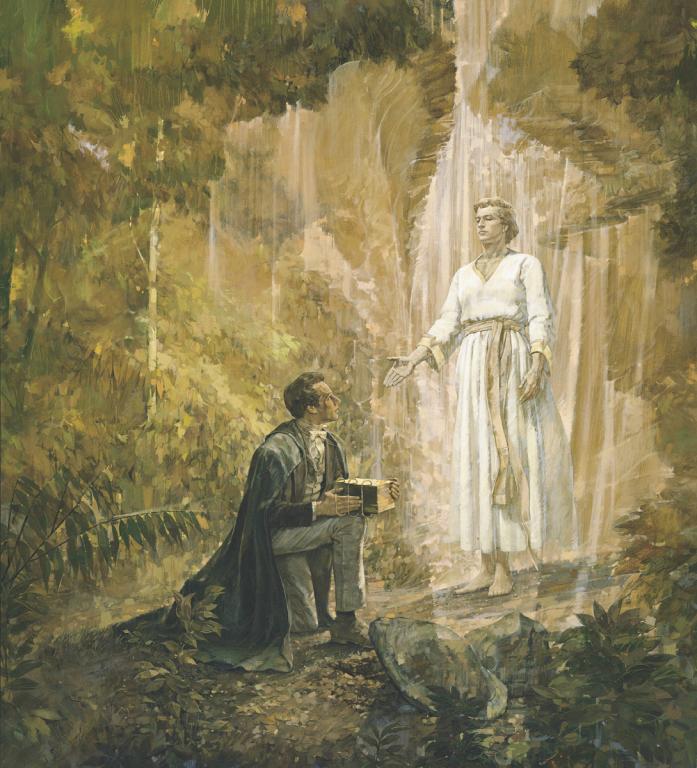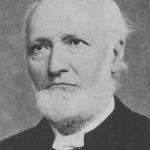
(Image from LDS.org)
For many, many decades until relatively recently, it was assumed by virtually everybody who rejected the Book of Mormon as an authentic work of ancient scripture — which is to say, by virtually everybody who ever gave the subject a passing thought — that, while it must have been written in the nineteenth century, it surely could not have been written by Joseph Smith. It seemed pretty clearly (and believing Latter-day Saints will overwhelmingly tend to agree) beyond Joseph’s capacity to have produced. By far the most popular alternative theory was that the Book of Mormon had been composed as a secular yarn by a clergyman named Solomon Spalding (or Spaulding, 1761-1816) and then somehow surreptitiously modified, “theologized,” and conveyed to Joseph Smith, probably by the Campbellite preacher Sidney Rigdon (1793-1876). The Book of Mormon was published on 26 March 1830, and the Church of Jesus Christ of Latter-day Saints was formally organized on 6 April 1830. Sidney Rigdon was baptized into the Church in Mentor, Ohio, on 14 November 1830.
As I say, I’ve been lately reading Richard S. Van Wagoner, Sidney Rigdon: A Portrait of Religious Excess (Salt Lake City: Signature Books, 1994). Van Wagoner was inclined to see Sidney Rigdon as a co-creator of “Mormonism” who had managed to insert his own ideas into what Joseph Smith claimed to be revelations. So it’s interesting to see Van Wagoner’s attitude toward the Spalding manuscript theory:
During the spring of 1833 or 1834, while visiting the home of Samuel Baker near New Portage, Ohio, Rigdon stated in the presence of a large gathering that he was aware some in the neighborhood had accused him of being the instigator of the Book of Mormon. Standing in the doorway to address the audience in the yard, he held up a Book of Mormon and said:
I testify in the presence of this congregation, and before God and all the Holy Angels up yonder (pointing towards heaven), before whom I expect to give account at the judgment day, that I never saw a sentence of the Book of Mormon, I never penned a sentence of the Book of Mormon, I never knew that there was such a book in existence as the Book of Mormon, until it was presented to me by Parley P. Pratt [in late October 1830 -dcp], in the form that it now is.
Such was Rigdon’s stance even on his deathbed. He confirmed that position repeatedly, as did his wife and at least three of his children, two of whom were non-believers in Mormonism. His oldest child, Athalia R. Robinson, in a notarized statement of 10 October 1900, said that the missionaries presented the book to her father in the presence of “My mother and myself. . . . This was the first time father ever saw the book of Mormon.” His son Wickliffe added in a 1905 interview that during a visit with his father,
then in his last years . . . I found him as firm as ever in declaring that he himself had nothing whatsoever to do in writing the book, and that Joseph Smith received it from an angel. On his dying bed he made the same declaration to a Methodist minister. . . . My mother also told me that Father had nothing whatever to do with the writing of the book, and that she positively knew that he had never seen it until Parley P. Pratt came to our home with it.
Nancy R. Ellis, Rigdon’s most anti-Mormon offspring, recalled in an 1884 interview the arrival of the missionaries in her Mentor, Ohio, home when she was eight years old: “I saw them hand him the book, and I am as positive as can be that he never saw it before.” . . . She further stated that her father in the last years of his life called his family together and told them, as sure as there was a God in heaven, he never had anything to do in getting up the Book of Mormon and never saw any such thing as a manuscript written by Solomon Spaulding. (141-142)
Further testimony comes from someone who, though a relative, had no particular affection for Joseph Smith or the Book of Mormon:
Rigdon’s minister cousin, John Rigdon, also left testimony denying his cousin’s involvement in producing the Book of Mormon, as recorded by Sidney Knowlton for John Page:
I hereby certify that I heard Rev. John Rigdon, a member of the Church of Disciples, known by the name of Campbellites, sometime in March, 1840, at his own residence in Fulton Co., Illinois, say in answer to a question propounded to him by Elder John E. Page, as follows, to wit: Question by Mr. Page — “Sir, what are your views in relation to Sidney Rigdon having any connection with the origin of the Book of Mormon, as it is reported, that he, Rigdon, had access to the Spaulding manuscript, from which he transcribed or originated the Book of Mormon”? Answer by Rigdon — “I do not believe from my acquaintance with him, (S. Rigdon) having known him from his infancy till after the publication of said Book of Mormon, as well as one can know another, being on the greatest terms of intimacy at the time said book was printed, and from all the circumstances connected with his life, character and conduct, that Sidney Rigdon had any doing whatever to do with it.” (146, note 8)
And there is also corroborating testimony from the highly intelligent Orson Hyde, who eventually served as a member of the Quorum of the Twelve Apostles of the Church of Jesus Christ of Latter-day Saints from 1835 until his death in 1878:
Orson Hyde made his own study of the matter. He concluded that during the time he lived in the Rigdon home, when Sidney was his pastor and mentor, there was not a single hint that Rigdon was working on a manuscript. Furthermore, he explained: “Forgery, deception, and romance formed no part of the principles which Mr. Rigdon taught me during the time that I was under his tuition, and I must say, that I should not have been more surprised if they had accused the Lord Bishop of London of the same things which they charge against Mr. Rigdon.” Hyde also recalled that when he had visited New Salem in the spring of 1832 and organized a branch of the church there, he had met no one who claimed to have found similarities between the Book of Mormon and the Spalding work. (146, note 13)
Richard Van Wagoner’s own verdict on the subject is quite clearly stated:
The weight of scholarly studies since Fawn Brodie’s seminal 1945 No Man Knows My History biography of Joseph Smith has all but eliminated the Spalding theory and Rigdon’s complicity. . . .
For those skeptical of the supernatural, answers must be sought elsewhere. . . . As William McLellin, an early Mormon leader and later apostate, affirmed years after he had left Mormonism:
You seem to think S. Rigdon the bottom of all M[ormon]ism. Many people know better. He never heard of the work of Smith & Cowdery, until C[owdery] and P[arley] P. Pratt brought the book to him in Mentor, O[hio]. True enough, I have but little confidence in S. Rigdon, but I know he was more the tool of J. Smith than his teacher and director. He was docile in J.S. hands to my knowledge.
If any one single item defined Rigdon it was his untiring belief in the authenticity of that “ancient voice from the dust.” It provided him the shelf on which he rested his soul. And in the end, when he was disillusioned and bereft of faith in Joseph Smith, he still avowed that the Book of Mormon was precisely what it claimed to be — the word of God. (144-145)













